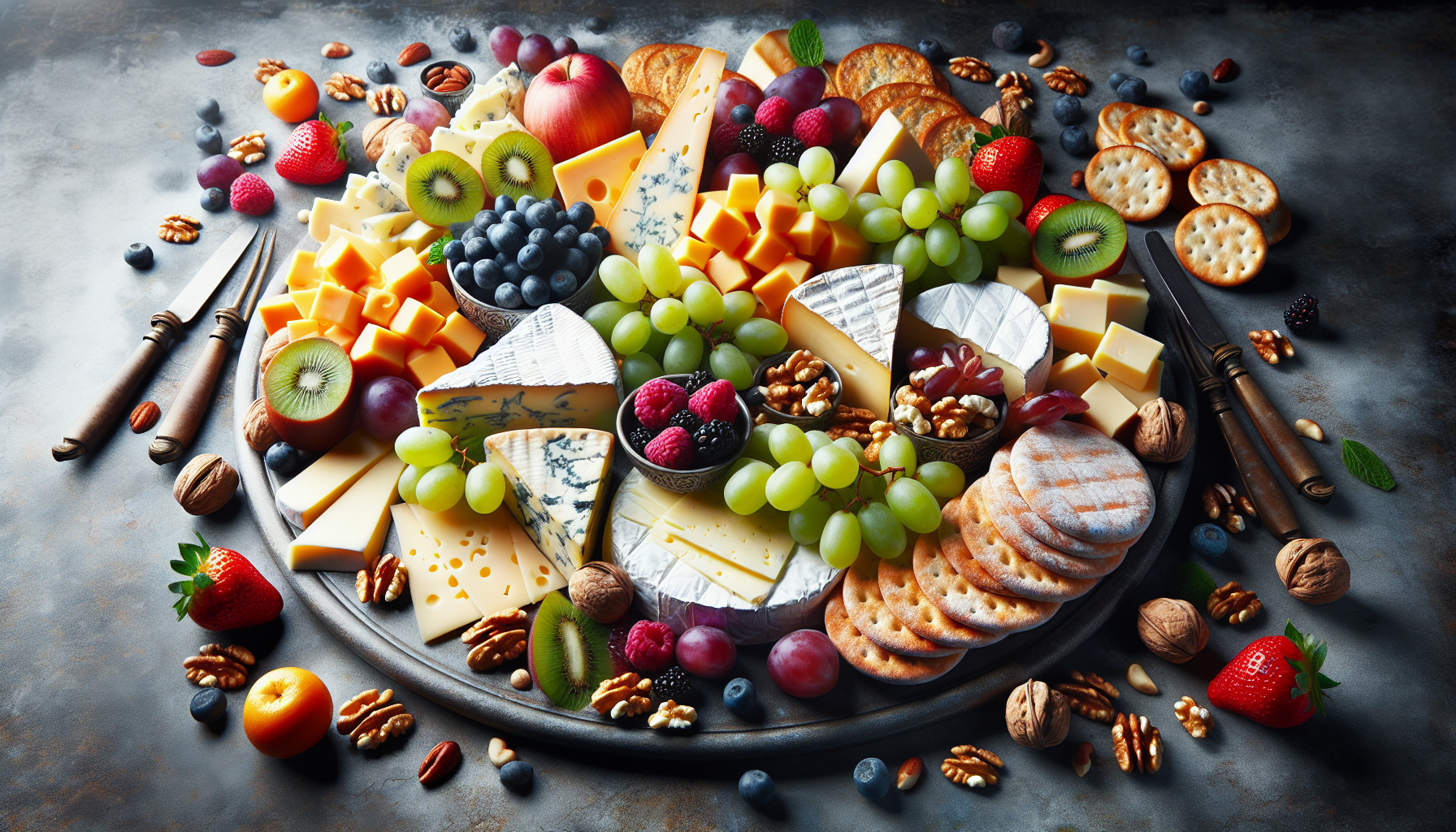Indulge in the art of creating the perfect cheese platter with expert pairings and stunning presentation. Whether you’re hosting a sophisticated gathering or simply treating yourself, Tastepan.com has all the inspiration you need. Elevate your culinary adventures with our mouthwatering recipes, carefully curated to tantalize your taste buds. With step-by-step instructions, ingredient lists, and expert tips, you’ll be able to craft a cheese platter that not only satisfies your appetite but also impresses your guests. So, get ready to embark on a delightful journey of flavor as we take you through the world of cheese and its perfect companions.

Choosing the Cheeses
When it comes to creating the perfect cheese platter, one of the most important steps is choosing a variety of cheeses. Understanding the different types of cheese and selecting a range of textures and flavors will ensure that your platter is diverse and appealing to a wide range of tastes.
Understanding the Types of Cheese
Cheeses can be categorized into various types based on their milk source, texture, and production methods. Some popular types include soft cheeses like Brie and Camembert, semi-soft cheeses like Havarti and Gouda, hard cheeses like Cheddar and Parmesan, and blue cheeses like Roquefort and Stilton.
When selecting cheeses for your platter, aim for a mix of different types to offer a variety of flavors and textures. This will create a more interesting and well-rounded experience for your guests.
Selecting a Variety of Textures and Flavors
In addition to choosing different types of cheese, it’s also important to consider the textures and flavors of the cheeses you include on your platter. This will add depth and complexity to your cheese selection.
For example, you might include a creamy, spreadable cheese like goat cheese or a soft cheese like Camembert. These cheeses provide a smooth and rich texture that pairs well with crusty bread or crackers.
You could also include a hard cheese like Parmesan or a semi-hard cheese like Gruyere. These cheeses offer a firmer texture and a more intense flavor that can be enjoyed on its own or paired with fruits and nuts.
By combining cheeses with different textures and flavors, you can create a cheese platter that offers something for everyone and provides a delightful sensory experience.
Selecting Accompaniments
While cheese is undoubtedly the star of the show, selecting the right accompaniments will enhance the overall taste and presentation of your cheese platter. Consider offering a variety of breads and crackers, fresh and dried fruits, nuts and seeds, as well as condiments and spreads.
Bread and Crackers
Bread and crackers are essential for enjoying cheese. Choose a selection of breads such as baguette slices, ciabatta, or whole grain bread to provide a neutral base for the cheese. Crackers with different flavors and textures, like water crackers or multi-grain crackers, can also add a delightful crunch to the platter.
Fresh and Dried Fruits
Fresh and dried fruits are a fantastic addition to any cheese platter. Fresh fruits like grapes, strawberries, and sliced apples provide a refreshing and juicy contrast to the richness of the cheese. Dried fruits such as figs, apricots, and cranberries offer a sweet and chewy element that complements the flavors of the cheese.
Nuts and Seeds
Nuts and seeds add a lovely crunch and earthy flavor to the cheese platter. Consider options like almonds, walnuts, pistachios, or pumpkin seeds. These add an additional layer of texture and provide a wonderful balance to the creamy and salty nature of the cheese.
Condiments and Spreads
To elevate the flavors of the cheeses, include a variety of condiments and spreads on your platter. Mustards, honey, chutneys, and fruit preserves are excellent choices. They add a burst of flavor and can be paired with specific cheeses to create delicious combinations.
By offering a diverse range of accompaniments, you give your guests the opportunity to experiment with different combinations and discover their own favorite pairings.

Creating a Beautiful Presentation
Once you’ve selected the cheeses and accompaniments for your platter, it’s time to focus on the presentation. A well-arranged cheese platter not only enhances the visual appeal but also makes it easier for guests to navigate and enjoy the various components.
Choosing the Right Platter
Selecting the right platter is essential for creating an eye-catching display. Opt for a large, flat platter with ample space to arrange the cheese and accompaniments. Wooden boards, slate boards, or elegant ceramic platters are all great options that can add a touch of sophistication to your presentation.
Arranging the Cheeses
When arranging the cheeses, start with the largest or most visually appealing pieces as the focal point. Place them in different corners or sections of the platter, leaving enough space between each cheese for guests to easily access and cut them.
Next, arrange the smaller cheeses around the larger ones, ensuring a good balance of colors and textures. This will create an attractive composition and allow guests to explore different varieties without any confusion.
Adding Accents and Garnishes
To further enhance the visual appeal of your cheese platter, consider adding accents and garnishes. Fresh herbs like sprigs of rosemary or thyme can provide a pop of green and a pleasant aroma. Edible flowers, such as pansies or nasturtiums, can add a touch of elegance and a splash of color. Additionally, small bowls or ramekins filled with olives or cornichons can add extra visual interest and provide tangy and briny accompaniments to the cheese.
Adding thoughtfully chosen accents and garnishes can elevate the overall presentation of your cheese platter and make it a visually striking centerpiece for any gathering.
Pairing Cheese and Beverages
Pairing the right beverages with your cheese selection can enhance the flavors and create a harmonious taste experience. Whether you prefer wine, beer, or non-alcoholic options, there are plenty of choices to explore.
Wine and Cheese Pairings
Wine and cheese have a long-standing relationship, and pairing the right wine with your cheese selection can elevate the flavors and create a delightful taste combination. Generally, it’s a good idea to match the intensity and flavors of the cheese and wine, creating complementary or contrasting flavor profiles.
For example, a creamy Brie or Camembert pairs beautifully with a crisp and acidic white wine like Sauvignon Blanc or a light-bodied red wine like Pinot Noir. A rich and nutty Gruyere or aged Cheddar may be best enjoyed with a full-bodied red wine like Cabernet Sauvignon or a bold white wine like Chardonnay.
Experimenting with different wine and cheese pairings can be a fun and educational experience, allowing you to discover new flavor combinations and preferences.
Beer and Cheese Pairings
While wine is often associated with cheese, beer can also be an excellent pairing choice. The carbonation and unique flavors of beer can create a refreshing and complementary contrast to the richness of cheese.
When pairing beer and cheese, consider matching the intensity and flavors of the beer with the cheese. Light and citrusy beers like wheat beers or lagers pair well with fresh and young cheeses like Mozzarella or Goat cheese. Dark and malty beers like stouts or porters can be enjoyed with robust and strong-flavored cheeses like Cheddar or Gorgonzola.
Don’t be afraid to experiment with different beer styles and cheese combinations to find the perfect match for your taste preferences.
Non-Alcoholic Options
For those who prefer non-alcoholic options or want to provide alternatives for guests, there are several beverages that pair well with cheese. Sparkling water, iced tea, or fruit-infused water can provide a refreshing and hydrating choice. Herbal teas or fruit smoothies can also be a great accompaniment, adding a touch of flavor and enhancing the overall taste experience. Be creative and offer a variety of non-alcoholic options to cater to all preferences.

Serving Tips and Etiquette
To ensure the best experience for your guests, it’s important to follow some serving tips and etiquette when it comes to your cheese platter.
Temperature and Timing
Cheese tastes best when served at the right temperature. Remove the cheeses from the refrigerator about 30 minutes before serving to allow them to reach room temperature. This will enhance their flavors and textures, making them more enjoyable to eat.
Keep in mind that guests may arrive at different times, so consider bringing out additional cheeses from the fridge as needed to maintain a consistent temperature throughout the event. Additionally, if you’re serving warm or melted cheeses, make sure they are kept at the appropriate temperature for serving.
Cutting and Serving Portions
When it comes to serving cheese, it’s important to provide guests with manageable portions that are easy to enjoy. Cut each cheese into small, bite-sized pieces to allow guests to try a variety of options without feeling overwhelmed.
Provide a dedicated cheese knife or spreader for each type of cheese to prevent flavor transfer and maintain the integrity of the individual cheeses. If you’re unsure about the appropriate way to cut a specific cheese, do some research or ask a knowledgeable cheesemonger for guidance.
Proper Use of Utensils
Make sure to provide appropriate utensils for serving and enjoying the cheese. Cheese knives with different shapes and sizes are designed for specific types of cheese, so having a variety on hand will make it easier for guests to serve themselves.
Provide small cocktail forks or toothpicks for guests to pick up their desired cheese and accompaniments. These utensils ensure that the cheeses and accompaniments are handled properly and hygienically.
Following these serving tips and etiquette will ensure that your guests have a seamless and enjoyable cheese platter experience.
Building Flavor Profiles
One of the joys of creating a cheese platter is the opportunity to experiment with different flavor profiles. By combining cheeses, accompaniments, and condiments that either contrast or complement each other, you can create a truly memorable and delicious experience.
Contrasting Flavors
Combining contrasting flavors on your cheese platter can create a dynamic and exciting taste experience. For example, pairing a creamy and mild cheese like Brie with a tangy and sharp cheese like Blue cheese creates a beautiful contrast. Similarly, combining sweet and savory flavors, such as fig jam with salty Parmesan, can create an interesting flavor interplay that keeps the palate intrigued.
When building contrasting flavor profiles, consider including a range of tastes such as sweet, salty, tangy, and spicy. This will ensure that every bite offers a unique and delightful combination of flavors.
Complementary Flavors
Complementary flavor combinations are all about harmonizing similar flavors and enhancing the taste experience. For instance, pairing a mellow and nutty Gouda with a sweet and caramelized onion chutney creates a beautiful harmony of flavors. Similarly, combining a rich and velvety Goat cheese with a drizzle of honey can create a delightful balance of sweet and tangy.
When building complementary flavor profiles, consider the flavor profiles of the cheeses and select accompaniments that enhance and amplify those flavors. This will create a cohesive and well-rounded taste experience for your guests.
Creating Harmonious Combinations
To create truly harmonious combinations on your cheese platter, aim for a balance of contrasting and complementary flavors. This will provide a well-rounded and satisfying experience that appeals to a variety of taste preferences.
Experiment with different cheese and accompaniment combinations, and don’t be afraid to step outside your comfort zone. You might discover unexpected flavor pairings that become new favorites.
Exploring Cheese Regions
Cheese production is deeply rooted in different regions around the world, and each region has its own unique cheese-making traditions and flavor profiles. Exploring cheese from various regions can be a culinary journey that allows you to discover new and exciting tastes.
French Cheese Regions
France is renowned for its wide variety of cheeses, each region offering its own specialties. From the creamy and luxurious Brie de Meaux to the pungent and distinctive Roquefort, French cheeses are beloved worldwide.
Consider including cheeses from different regions of France on your platter to showcase the diverse flavors and textures that this country has to offer. Explore options like Camembert from Normandy, Comté from Franche-Comté, or Chaource from Champagne-Ardenne.
Italian Cheese Regions
Italy is famous for its exquisite cheeses, many of which are key ingredients in beloved dishes such as pasta and pizza. From the milky and soft Mozzarella to the sharp and tangy Parmigiano-Reggiano, Italian cheeses are a delight to both the palate and the senses.
When including Italian cheeses on your platter, consider different regions like Lombardy, where Gorgonzola and Taleggio are produced, or Tuscany, where Pecorino and Ricotta are popular choices. Each region offers its own unique and delicious cheese varieties.
Spanish Cheese Regions
Spain has a rich and diverse cheese-making heritage that spans across different regions. The country is known for its sheep’s milk cheeses, which offer a bold and distinctive flavor. Cheeses like Manchego, Idiazabal, and Mahón are just a few examples of the delicious Spanish cheeses available.
By including Spanish cheeses on your platter, you can introduce your guests to the unique flavors and textures that this region has to offer. Experiment with different varieties and discover new favorites along the way.
Exploring cheeses from different regions allows you to celebrate the cultural and culinary diversity of the cheese-making world and creates an educational and memorable experience for your guests.
Customizing Your Cheese Platter
To make your cheese platter truly personal and tailored to your preferences, consider customizing it based on dietary restrictions and incorporating local and artisanal cheeses.
Considering Dietary Restrictions
When planning your cheese platter, it’s important to consider the dietary restrictions and preferences of your guests. Offering a selection of cheeses that accommodates various dietary needs ensures that everyone can enjoy the platter.
For guests who are lactose intolerant or follow a dairy-free diet, consider including alternative options such as vegan cheeses made from nuts or soy. For those following a gluten-free diet, ensure that your bread and cracker options are gluten-free.
Being mindful of dietary restrictions demonstrates thoughtfulness and inclusivity, ensuring that everyone can partake in the cheese platter experience.
Incorporating Local and Artisanal Cheeses
Supporting local cheese producers and incorporating artisanal cheeses adds a unique touch to your cheese platter. Local and artisanal cheeses often capture the essence of their region, offering distinct flavors and craftsmanship.
Explore local farmers’ markets or specialty cheese shops to discover hidden gems produced in your area. By including these cheeses on your platter, you not only support local businesses but also offer your guests a taste of the culinary heritage of your region.
Customizing your cheese platter based on dietary restrictions and including local and artisanal cheeses will add a personal touch and create a truly memorable experience for your guests.
Cheese Platter Themes
To add an extra element of creativity and excitement to your cheese platter, consider incorporating different themes. Whether you want to embrace the flavors of the season or showcase cheeses from a specific region or country, themed cheese platters offer a unique and immersive experience.
Seasonal Cheese Platter
Adapting your cheese platter to the flavors of the season can be a delightful way to celebrate the changing seasons. Incorporate cheeses and accompaniments that align with the seasonal produce and flavors. For example, a spring-themed platter might include fresh cheeses, such as goat cheese or Feta, along with vibrant fruits like strawberries and apricots. In contrast, a winter-themed platter might feature hearty and aged cheeses such as Gruyere or aged Cheddar, paired with dried fruits like figs and dates.
By embracing the flavors of the season, you can create a cheese platter that reflects the freshness and vitality of the time of year.
Regional Cheese Platter
Take your guests on a culinary journey by showcasing cheeses from a specific region or country. This theme allows you to immerse your guests in the flavors and traditions of a particular locale. For example, a French-themed platter might include cheeses like Camembert, Brie, and Roquefort, along with traditional French accompaniments like baguette slices and Dijon mustard. Similarly, an Italian-themed platter could feature cheeses like Mozzarella, Parmigiano-Reggiano, and Gorgonzola, paired with Italian bread and pesto.
Embracing a regional theme creates a cohesive and immersive experience for your guests, transporting them to the culinary traditions of a specific region.
International Cheese Platter
If you want to explore a wider variety of flavors and textures, consider creating an international cheese platter. This theme allows you to choose cheeses from different countries and regions around the world, showcasing the diversity and global nature of cheese-making.
For example, you could include cheeses from France, Italy, Spain, and other countries known for their cheese production. Pair the cheeses with accompaniments that complement their flavors, such as olives, dried fruits, and specialty breads from each respective country. This international cheese platter will take your guests on a global taste adventure, allowing them to experience the world of cheese from the comfort of their plate.
By incorporating different themes into your cheese platter, you add an extra layer of creativity and excitement, making it an unforgettable experience for your guests.
Tips for Leftover Cheeses
If you find yourself with leftover cheeses after your cheese platter extravaganza, fear not! There are ways to properly store and repurpose your leftover cheeses to ensure they are enjoyed to their fullest potential.
Proper Storage and Shelf Life
To maintain the quality and freshness of your leftover cheeses, it’s important to store them correctly. As a general rule, wrap each cheese type separately in wax or parchment paper to allow the cheese to breathe and prevent it from drying out. Then, place the wrapped cheeses in airtight containers or resealable bags to protect them from absorbing other flavors in the refrigerator.
Soft cheeses like Brie or Camembert can last for about 1-2 weeks when stored properly. Hard cheeses like Cheddar or Parmesan can last for several weeks or even months. However, it’s important to keep in mind that the flavor and texture of the cheese may change over time.
Whenever possible, try to consume the leftover cheeses within a few weeks to ensure the best taste experience. Cheese that has passed its prime can still be used for cooking or baking, even if it’s not ideal for eating on its own.
Ideas for Repurposing Leftover Cheese
Leftover cheese can be repurposed and enjoyed in a variety of delicious ways. Here are a few ideas to make the most of your cheese leftovers:
-
Cheese Boards and Fondue: Combine different leftover cheeses to create a unique cheese board for another gathering. You can also melt the cheeses together with some white wine or beer to create a flavorful cheese fondue.
-
Grilled Cheese Sandwiches: Use leftover cheese to create gourmet grilled cheese sandwiches. Experiment with different breads, spreads, and accompaniments to elevate this classic comfort food.
-
Pasta Dishes: Grate or dice leftover hard cheeses like Parmesan or Gruyere to use as a topping for pasta dishes. The rich and nutty flavors of these cheeses can add depth to any pasta sauce.
-
Cheese Soups and Quiches: Incorporate leftover cheese into creamy soups or quiches. The cheese will add richness and flavor to these dishes, making them even more satisfying.
-
Cheese Puffs or Cheesy Bread: Use leftover soft or semi-soft cheeses to make delicious cheese puffs, or spread them on bread slices and bake for a quick and cheesy appetizer.
Don’t let your leftover cheeses go to waste. Get creative and experiment with different recipes to make the most of your cheese leftovers.
In conclusion, creating the perfect cheese platter requires careful consideration of the cheeses, accompaniments, presentation, pairings, and themes. By selecting a variety of cheeses, understanding their different textures and flavors, and pairing them with suitable accompaniments, you can create a cheese platter that caters to diverse tastes. Thoughtful presentation, proper serving etiquette, and the exploration of different flavor profiles further enhance the cheese platter experience. Exploring cheese regions, customizing the platter, and incorporating themed elements add personalization and creativity. Finally, repurposing leftover cheeses ensures that no delicious morsel goes to waste. So, gather your cheeses, unleash your creativity, and prepare to wow your guests with a cheese platter that’s as beautiful as it is delicious!

